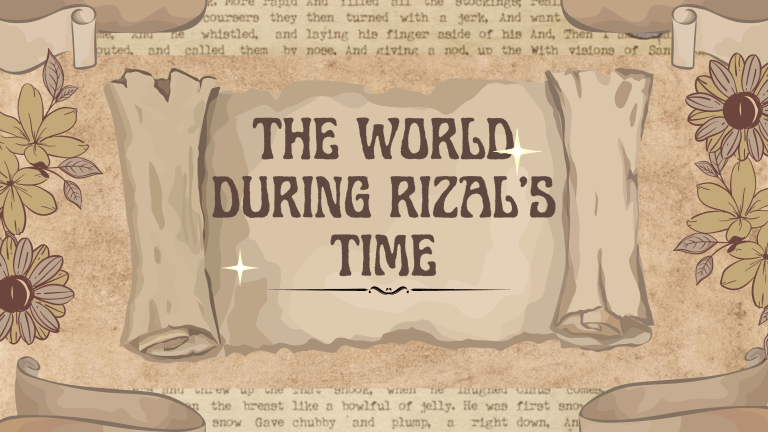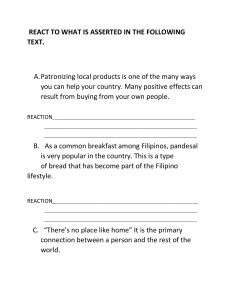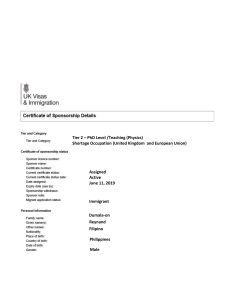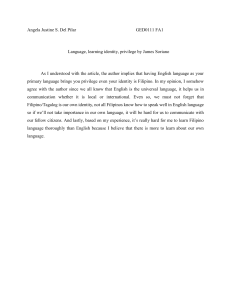
THE WORLD DURING RIZAL’S TIME TOPICS TO BE DISCUSSED Rizal’s Century: The 19th Century The Needs for Reform The Conditions of The Changing Europe, America, and Religious Front in the Asia Philippines: Secularization RIZAL’S CENTURY: THE 19TH CENTURY (1800-1899) https://i.pinimg.com/474x/9c/13/e6/9c13e6e909f6c165879 2d17a762193b4.jpg RIZAL’S CENTURY: THE 19TH CENTURY (1800-1899) “Age of Enlightenment” There were major changes that happened when it comes to man and the society “who would inherit the throne among his children? Charles or Isabelle? the Spanish crown has implemented the Canovite System or Rotativism. CONSERVATION AND LIBERALISM Conservatives believe that monarchs and kings should rule over their subjects. Liberals believe that a country should be free from domination by another, and that people should enjoy having liberty, equality, and opportunity. ADMINISTRATION ORGANIZATION 01 02 03 KING OF SPAIN VICEROY GOVERNOR - GENERAL The one who rules over A representative of The head of the Spanish Mexico, which is also a Colonial government, colony of Spain, that acts as the leader for the Philippines appointed directly by the King of Spain. THREE BODIES 01 02 03 RESIDENCIA VISITADOR ROYAL AUDIENCIA Inspect the movements They don’t stay in the This is the highest of the Governor- Philippines, however, supreme court in the General while residing they come from time- Philippines, however, it in the Philippines. to-time to visit and is also under the inspect. Governor-General. the French Revolution (1779-1789) and American Civil War (1755-1783) has also greatly contributed to the thinking of the people in the 19th Century. THE THREE FILIPINO CATHOLIC PRIEST Father Jose Burgos, Father Mariano Gomes, and Father Jacinto Zamora, also known as “GOMBURZA” has greatly awakened the strong feeling of anger and resentment of the Filipinos. Dedication of El Filibusterismo Led to the creation of the Propaganda Movement THE TRANSITION FROM ENCOMIENDA TO HACIENDA LABOR SYSTEM One of the changes during the 19th century. Done by granting a large amount of land to the settlers of the Americas Claiming the ownership of all the resources and of the natives THE MANILA-ACAPULCO GALLEON TRADE Has been the main source of income of the colonies during the early times. INDULTO DE COMERCIO An exclusive right granted to the alcalde mayores to control domestic trade, manipulate prices, and regulate business activities. Polo y Servicio or Forced Labor was a mandatory labor requirement lasting 40 days, S E X A T / E T U B I R T Implemented in various ways to sustain the colony DIRECT TAXES Required individuals to give 10% of their yearly income to the government SANCTORUM A tax specifically allocated to support the church TRIBUTES Known as “buwis,” was a form of tax or rent that residents had to pay to their landlords. THE EDUCATIONAL SYSTEM IN THE PHILIPPINES The year when Spain recognized the necessity of creating 1855 a public education system for the indigenous population. 1861 1863 It is the year where the Commission finished and submitted the report to Spain. The year when the Educational Decree of 1863 was officially promulgated. PROVISIONS OF EDUCATIONAL DECREE OF 1863 1. Establishments of Teacher Training School. 2. Government supervises the public school system. 3. Use of Spanish as medium of instruction in all schools 4. Establishment of one primary school for boys and for girls in each of the major towns. DARK SINISTER SHADOW OF SPAIN’S DECADENCE 1. The colonial administration was marked by instability. 2. There was widespread corruption among officials. 3. Filipinos had no representation in the Spanish Cortes (parliament). 4. Filipinos were denied basic human rights. 5. There was no equal treatment before the law. 6. The administration of justice was often mishandled. 7. Discrimination on racial grounds was prevalent. 8. The Church had significant influence in governance, leading to "Frailocracy." 9. Forced labor, known as "polo y servicio," was imposed on Filipinos. 10. The friars owned large agricultural estates known as haciendas. 11. The Guardia Civil played a role in maintaining order, sometimes with force. THE NEEDS FOR REFORM https://i.pinimg.com/474x/9c/13/e6/9c13e6e909f6c165879 2d17a762193b4.jpg NATURE OF THE REFORM MOVEMENT Attempts to uncover the injustices of Spanish colonialism in Madrid, Spain, specifically the excesses of the friars and the guardia civil. The assimilation of the Philippines to Spain was to take place in a peaceful manner. GREAT REFORMIST Graciano Lopez-Jaena, Marcelo H. del Pilar, José Rizal, Antonio Luna, Mariano Ponce, José M. Panganiban, Eduardo de Lete, and a few others who played a more or less passive role in the reform movement. Reform campaign was termed the Propaganda Movement because they used the press to spread their ideas. DURING THE TIME OF DR. JOSE RIZAL, THE FILIPINO SUFFERED UNDER THE WEIGHT OF SPANISH MISRULE, FOR THEY WERE UNFORTUNATE VICTIMS OF THE UNJUST, BIGOTED, AND DETERIORATING COLONIAL POWER. F O Y T I L I INSTAB L A I N O L CO N O I T A R T S I N I M AD Instability of Spanish politics since the turbulent reign of King Ferdinand VII The Spanish government underwent frequent changes owing to bitter struggle between the forces of Liberalism and Despotism. CORRUPT HUMAN RIGHTS DENIED OFFICIALDOM/FRIARS TO FILIPINOS Accepting bribes from the casinos in Manila which he scandalously allowed to operate. Filipinos were deprived of their freedom of speech, press, association, and other human rights except the freedom of religion. MALADMINISTRATION OF JUSTICE Spanish Judges, fiscals and other court officials were inept, venal and oftentimes ignorant of law. Wealth, social prestige, and color of skin were preponderant factors in winning a case in court. The judicial procedure was so slow and clumsy that it was easy to have justice delayed and under the popular maxim "justice delayed is justice denied.” SUBSTANTIAL VICTIMS OF SPANISH REQUIREMENTS OF INJUSTICE: DUE PROCESS: 1. Dona Teodora 2. Dr. Rizal 3. Paciano and several brothers-in-law 4. GOMBURZA fathers 1. The right to counsel. 2. The right to be heard and to confront witnesses and cross examine them. 3. The right to present evidence. 4. The speedy trial. RACIAL DISCRIMINATION Spain introduced Christianity's egalitarian concept of the Brotherhood of All under God the Father, but Filipinos were regarded Spaniards derisively called brown-skinned and flat nosed Filipinos "Indios" (Indians) Filipino men and women were treated no less than an animal. Y C A R C FRAILO Arose from Union of Church and State Known as the government of the friars Friars (Augustinians, Dominicans and Franciscans) controlled the religious and educational life of the Philippines FORCED LABOR OR “POLO Y SERVICIOS’ Polo, Polistas are the people who work polo Construction of churches, Schools, Hospitals, Building and repair of roads and bridges, and Building of ships in the shipyards & other public works Royal decree of July 12, 1883 increased the minimum age of the polistas (16-18 yrs old up to 60) Filipinos came to hate the forced labor because of the abuses connected with it: Spanish residents were not recruited Filipino polistas only receive only part of 2 pesetas, sometimes nothing It causes so much inconvenience and suffering THE CONDITIONS OF EUROPE, AMERICA, AND ASIA THE CONDITIONS OF EUROPE, AMERICA, AND ASIA Through the Industrial Revolution, Europe dominated the nineteenth century, establishing empires and acquiring colonies. The United States underwent rapid growth, including a change from agricultural to industry, westward expansion, and civil war. Trade globalization, imperialism, and inflation have had a substantial influence on the Asian culture and monetary system. CONDITIONS OF EUROPE 19th century: Birth of Modernity, transition to a new era Industrial revolution: Shift to machine-based manufacturing, new production methods Political Revolutions: American and French Revolutions influenced by Enlightenment Enlightenment values: Emphasis on reason, rationality, individualism over tradition Challenges to monarchy: French Revolution, impact on absolute monarchies in Europe Napoleon Bonaparte: French Empire, restored Bourbon dynasty Spread of Enlightenment ideas worldwide. CONDITIONS OF EUROPE 1848 (Before the birth of Rizal): Europe went into revolution from the monarchs in France. On the other hand, Austria fell as people sought a more responsible government. During this time, people struggle for equality on their rights spread around the world. 1861 (year of Rizal's birth): Under Giuseppe Garibaldi, Italy cast out the Austrians and took over the papal lands. Due to the Italian's nationalism, the domination of the church ended, and various states of Italy were united in one country. On the other hand, Germany was undergoing unification which lasted until the year 1871. CONDITIONS OF EUROPE Europe in the 1810s and 1820s: - Britain flourishing due to Industrial Revolution - France undergoing political changes from French Revolution - Spain facing political instability Spain's First Carlist War: - Carlists (conservatives) vs. Liberals - Carlists for absolute monarchy, Liberals for constitutional monarchy Spain's losses in the Peninsular War and Battle of Trafalgar: - Lost colonies in North, Central, and South America - Impact on marine trade between Philippines and America. CONDITION OF AMERICA War of 1812 (1812-1815): Fought between the United States and Great Britain Reasons: Impressment of American sailors, commerce disputes, western expansion, Native American policies. Mexican-American War (1846-1848): Sparked by Mexico's refusal to acknowledge Texas independence and American westward expansion. Civil War (1861-1865): North vs. South America Fought over slavery, deadliest North American conflict. Spanish-American War (1898): Triggered by support for Cuban and Filipino independence and USS Maine explosion. United States gained territory from Spain. CONDITIONS OF AMERICA Social and Cultural Changes: Church gains believers, anti-alcohol movement begins, and disputes affect farmers. Feminist movement started in 1848 with Seneca Falls Declaration of Sentiments. Slavery abolished in 1865 with the 13th Amendment. Chinese Exclusion Act in 1882 due to Chinese immigration, leading to discrimination. Racial discrimination, as seen in Rizal's encounter with racism in San Francisco in 1888. The government's harsh stance on Chinese immigration for political support. CONDITIONS OF ASIA Asian Monetary System in the 19th Century: Altered by globalization of trade, colonization, an d inflation. Globalization and Trade: Expansion of international trade led to increased cu ltural contact, often through violence. Opium War (1839-1842) resolved prolonged trade dispute between Britain and China. Colonization in Southeast Asia: Colonization by Britain, France, and Holland in the 19th century. Significant impact on the region's population and economy. Cultural and Economic Traditions: Flourishing of traditions in Asia during this period. Religious art remains conservative and resistant to Westernization. Valuable items include textiles, metals, jewelry, an d ceramics in indigenous courts. THE CHANGING RELIGIOUS FRONT IN THE PHILIPPINES: SECULARIZATION https://i.pinimg.com/474x/9c/13/e6/9c13e6e909f6c165879 2d17a762193b4.jpg E H T F O R E W O P CHURCH When the Spaniards colonized the country they brought religion with them and it was spread throughout the nation. Churches are built and Parishes are established, it spread even more thanks to their evangelization. Because of the widespread of religion even the church obtained political power. EXAMPLE OF INFLUENCE THAT THE CHURCH HAD Educational Insitution - Church operates and controls the school it became known as parish school or catholic church and students are converted into the Catholic Faith. Religious Official - Priests do not only pray and worship they are also a guardian of public morals, advisers to the governor-general, keepers of the list of residential, and many more. N O I T A Z I R A L SECU g n i t r e v n o c f o s s e c The pro a e k i l s u o i g i l e r g n i h t some r o r a l u c e s a o t h s i par a o t t s e i r p r a l u g e r g replacin a g n i n r e v o g n i t s e i r secular p . h s i r a p a church or TWO KINDS OF PRIEST REGULAR PRIEST 01 Priest that are inside a religious orders. Their main task is to spread Christianity throughout the country. Example were the Jesuits, Franciscans, Dominicans, Recollects and Augustinians. SECULAR PRIEST Priest that have no relations to any religious orders. 02 Their task was to ran the parishes and were under the supervision of the bishops. N O I T A Z I R A L SECU o t t s e i r p h s i n a p S g n i Replac d n a g n i g a n a m n o t s e i r p o n i p Fili . s e h c r u h c g n i n r e v o g g n i v a h y b s e h c r u h c g n i z i l a n o i Nat n a h t t i r e v o e k a t t s e i r p o n i p i l i F t s e i r p h s i n Spa F O N O I EXPULS 7 6 7 1 N I S T I U S JE King Carlos III of Spain signed orders on February 27, 1767 to expel all Jesuits from his lands. Jesuits were denounced as traitors to, and adversaries of, the king and the state. When Jesuits left the country it created more opportunities for filipino seculars to occupy some parishes. F O N O I EXPULS 7 6 7 1 N I S T I U S JE In 1858 Jesuits were allowed to return to the country, and the parishes held by the seculars were given back to the regulars. The parishes held by the seculars were returned to the regulars in a process known as reverse secularization. The secularization issue has evolved into a racial debate since it pitted Filipino seculars against Spanish regular clergy. The Spanish King and the Pope issued the orders fo r the secularization of the Philippine’s parishes, Som e religious regulars lay down their opposition about giving secular priests more responsibility within the parishes, like arguing that the Filipino seculars were never prepared and ready to take over but it is clear that the reason for not allowing secularizatio n is just racist reasoning. Such as Filipino’s skin color, level of education and not enough experience. LEADERS OF SECULARIZATION The issue was between the Spanish regulars and the Filipino seculars. Many Filipino seculars advocated for equal rights between Filipino and Spanish citizens and to reduce the power and influence of the church within politics. Known Secular Priest who advocated for it are Father Pedro Pablo Pelaez, Father Mariano Gomez, Father Jose Burgos. and Father Jacinto Zamora FATHER PEDRO PABLO PELAEZ THE “GODFATHER OF PHILIPPINE RE VOLUTION” AND “LEADER OF FILIPINO CLE R G Y ” During the Royal Decree in 1849 a few parishes that were governed by secular priests were given to regular priests same situation with the re turn of Jesuits in 1858. Father Pelaez started organizing activities calling for the return of control of Philippin e parishes to Filipino secular. He even wrote a formal protest titled “El Clero Filipino”. https://i.pinimg.com/474x/9c/13/e6/9c13e6e909f6c165879 2d17a762193b4.jpg GOMBURZA Father Mariano Gomez - He spent his life writing about abuses against Filipino priests. He helped in maintaining a harmonious relationship among his other priests. Father Jose Burgos - He continued his teacher’s unfinished mission of secularization. In “To the Spanish People,” an open letter of 1871, he appealed for reform and a greater measure of self-determination for the Filipinos and attacked the power and privilege of the church. Father Jacinto Zamora - He witnessed the unjust treatment of the Spanish friars against Filipino priests. Father Zamora led a campaign against the abusive Spanish friars and fought for equal rights among priests. https://i.pinimg.com/474x/9c/13/e6/9c13e6e909f6c165879 2d17a762193b4.jpg N I E G N CHA N O I T A R T S I N I M D A From 1869 to 1871 Governor-General Carlos Ma. de la Torre administration Filipino seculars were allowed to voice their grievances and problems about the system But the administration change and became Governor-General Izquierdo's regime (1871-1873) they Filipinos were not allowed to talk and were suppressed through fear. GOVERNOR GENERAL IZQUIERDO He served as Governor-General of the Philippines from 4 April 1871 to 8 January 1873. He was famous for his use of "Iron Fist" type of government, contradicting the liberal government of his predecessor, Carlos María de la Torre y Navacerrada. He implemented harshes law to everyone, added tax to previous tax exempted jobs and ruled with an iron fist. This led to the 1872 Cavite Mutiny. https://i.pinimg.com/474x/9c/13/e6/9c13e6e909f6c165879 2d17a762193b4.jpg EFFECT OF 1872 CAVITE MUTINY Fathers Gomez, Burgos, and Zamora were identified by a false witness named Francisco Zaldua, who pointed out that the three priests were indeed part of the mutiny and out to lead a government that would overthrow the Spaniards and install Father Burgos as the future leader of the Philippines. Even though there is a protest and a lack of evidence GOMBURZA were accused and found guilty of allegedly orchestrating the Cavite Mutiny of 1872, and charged with treason and sedition by Spanish authorities. They were sentenced to public execution by garrote on February 17, 1872, in Bagumbayan, Philippines. THANK YOU





